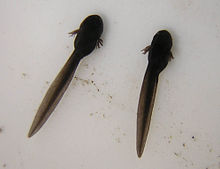ဖားလောင်း
ကုန်းနေရေနေ သတ္တဝါများ၏ သားလောင်း
ဖားလောင်းသည် ကုန်းနေရေနေ သတ္တဝါ၏ ဇီဝကမ္မဖြစ်စဉ်မှ သားလောင်းအဆင့်ဖြစ်သည်။ ဖားလောင်းအများစုသည် ရေနေသတ္တဝါများဖြစ်သော်လည်း အချို့သော ကုန်းနေရေနေ သတ္တဝါများ၏ သားလောင်းဘဝသည် ကုန်းပေါ်တွင်သာ နေထိုင်ရှင်သန်သော မျိုးစိတ်များလည်ရှိသည်။ ဖားလောင်းများတွင် ငါးများကဲ့သို့ပင် ဘေးတိုက် အတန်း၊ ပါးဟက်နှင့် ရေကူးနိုင်သော အမြီးပြားများ စသော အရွယ်ရောက်ပြီး ကုန်းနေရေနေသတ္တဝါများတွင် မတွေ့ရနိုင်သော အင်္ဂါရပ်များရှိသည်။ ၎င်းတို့သည် အသွင်ပြောင်းသောအခါ လေကို ရှူရန်အတွက် အဆုတ်များ စတင်ဖွံ့ဖြိုးလာပြီး ဖားလောင်း၏ အစာသည်လည်း သိသိသာသာ ပြောင်းလဲလာသည်။[၁][၂]




ကိုးကား
ပြင်ဆင်ရန်- ↑ The Grammarphobia Blog: On tadpoles and pollywogs (2012-05-01)။ 2016-08-22 တွင် မူရင်းအား မော်ကွန်းတင်ပြီး။ 2016-08-08 တွင် ပြန်စစ်ပြီး။ “The word is a compound of the Middle English tade or tadde (toad) and, apparently, the noun "poll" (head or roundhead), Oxford says. [...] Its earliest appearance in writing—spelled "polwygle"—is from 1440, the OED says. That very odd-looking word was originally derived, Oxford says, from "poll" plus "wiggle".”
- ↑ Crump, Martha L. (2009). "Amphibian diversity and life history". Amphibian Ecology and Conservation. A Handbook of Techniques: 3–19. Archived 15 July 2011 at the Wayback Machine. မော်ကွန်းတင်ပြီးမိတ္တူ။ 15 July 2011 တွင် မူရင်းအား မော်ကွန်းတင်ပြီး။ 4 January 2023 တွင် ပြန်စစ်ပြီး။